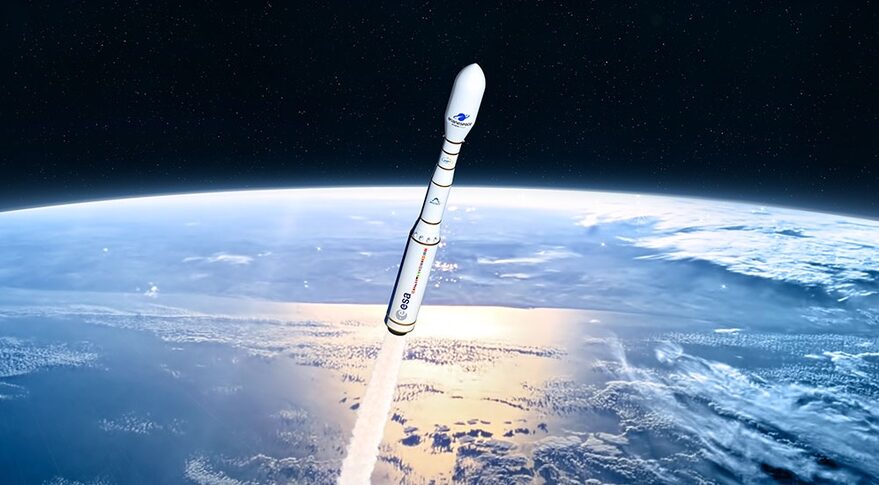
Vega C to launch five Copernicus spacecraft (Image Credit: Space News)
WASHINGTON — The European Commission awarded a contract to Arianespace Nov. 29 for launches of five Copernicus Earth observation spacecraft on Vega C rockets between 2024 and 2026.
The contract, Arianespace Chief Executive Stéphane Israël said in a press conference, secures the position of the European Commission, which operates both Copernicus and the Galileo navigation constellation, as the launch provider’s top institutional customer.
“The Copernicus contract that we have signed today is a mark of the deep relationship that we have with the European Commission,” he said, calling the commission the company’s best customer.
The contract includes the launch of Sentinel-1D, a synthetic aperture radar mission in the second half of 2024; Sentinel-2C, a high-resolution land imaging satellite in mid-2024; Sentinel-3C, an optical, radar and altimetry satellite slated for launch in 2024 or 2025; and Sentinel CO2M-A and CO2M-B, two satellites for studying carbon dioxide emissions that will launch separately in 2025-2026. They join Sentinel-1C, which Arianespace won a contract in April to launch on a Vega C in 2023.
Israël declined to give the value of the contract but claimed the value was “very competitive” with American launch vehicles. “What we sold for Sentinel is highly competitive as opposed to what I have seen when one has been launched from the U.S.”
It’s unlikely the European Commission, whose leadership has emphasized the importance for autonomous European access to space, would have gone with another launch provider. However, the enhanced payload capacity of the Vega C, which made its debut in July, enabled the selection of that vehicle.
Israël said four of the satellites, including Sentinel-1C, could not have launched on the original Vega. “Vega C allows us to deploy the Copernicus constellation.”
Two of the satellites, Sentinel-2C and -3C, are small enough to allow the launches to accommodate secondary payloads, said Marino Fragnito, senior vice president and head of the Vega business unit at Arianespace. The company has a provision in its launch contract to incorporate additional satellites on those launches, with “a few institutional co-passengers” planned to go on the Sentinel-2C launch.
The Copernicus contract brings the Vega C backlog to 13 launches, with two additional launches of the original Vega. One of the two Vega launches, Fragnito said, is for the European Space Agency’s Biomass satellite, while the other is tentatively set to launch the PLATiNO imaging satellite for the Italian Space Agency.
Vega C was scheduled to perform its first commercial launch Nov. 24, carrying two Pléiades Neo imaging satellites for Airbus, but Arianespace postponed the launch because of an unspecified technical issue with the rocket. That launch has been postponed to Dec. 20, with an Ariane 5 launch moved up a day to Dec. 13.
Fragnito said the problem was with pyrotechnics in the payload fairing separation system, which could not be repaired on the pad. “We had to bring the upper composite back to the integration facility, open the fairing, change the equipment, close it and bring it back to the launch pad,” he said. “This takes some weeks.”
Israël thanked the French space agency CNES, which operates the Kourou launch site, for reducing the time between launches to seven days to allow the launches to take place back-to-back.
In addition to the Copernicus launches, Arianespace has five Galileo launches on its manifest. That includes two originally scheduled to launch on Soyuz, which is no longer available after Russia’s invasion of Ukraine. Negotiations on how to handle those launches are ongoing, he said, with no resolution yet.
Israël said he expected that, once the Soyuz launch contract issue is resolved, he expected to finalize a framework contract with the European Commission for launching the next-generation Galileo satellites. “We first have to solve the force majeure issue, which is not an easy one.”
He also expects Arianespace to play a role in the commission’s secure connectivity constellation, recently named Infrastructure for Resilience, Interconnectivity and Security by Satellite or IRIS². “Ariane 6 is perfectly adapted to deploy the IRIS² constellation. It could be complemented by Vega C,” he said. “Nothing is decided yet, and it would be the choice of the European Commission.”








